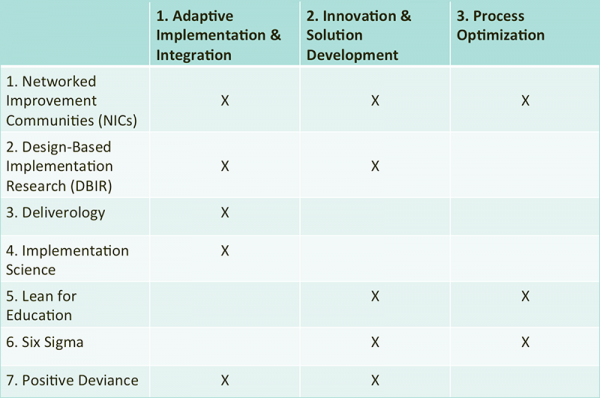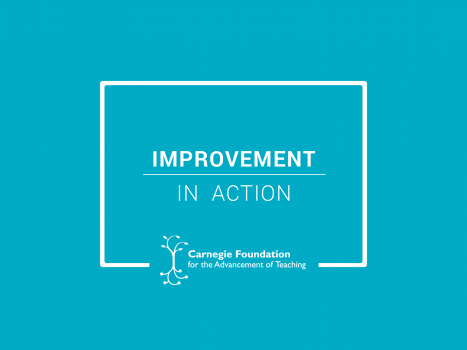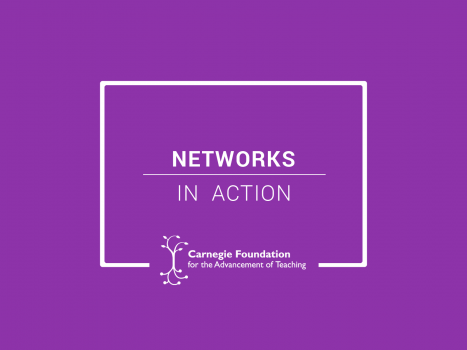Editor’s note: The current issue of Quality Assurance in Education is a special one, devoted entirely to exploring seven different improvement-based approaches to change being used in schools. Over several weeks, the Carnegie Foundation will publish blog posts summarizing each of the models, including the process, examples, and pros and cons. “Implementation Science” is written by Lee E. Nordstrum of RTI International, Paul G. LeMahieu of the Carnegie Foundation, and Elaine Berrena with the Bennett Pierce Research Center at Pennsylvania State University. We hope that these summary blog posts will whet your appetite to delve more deeply into the journal itself.
As the name suggests, implementation science is a method of improvement that concentrates on how education changes are carried out to ensure that the implementation process accounts for local variables in schools and other relevant contextual factors in order to be successful in any setting. New research has found that personal beliefs, behaviors, and values of people involved in implementing reforms can affect the quality of implementation and, therefore, the outcomes. This is one reason that, although teachers are central to implementing new programs, implementation science recommends that no single group should be solely responsible for putting an intervention in place. For example, research has found that when teachers implement a program, they don’t necessarily change their instructional strategies to fit the change. Therefore, external facilitators are needed during implementation to train teachers on the best instructional practices to achieve quality and effective outcomes. Similarly, often implementation may call for changes in pedagogy without recognizing or addressing constraining contextual factors that militate against such change.
The model arose in the healthcare field as early as the 1940s, when researchers and healthcare professionals noticed that promising results of interventions tested in controlled settings were not getting the same outcomes in real-life clinical practices (note that this issue lies at the heart of the distinction between efficacy and effectiveness). In other situations, the programs might work in one place but not in another, raising questions about what transpired between the lab and the actual practice.
Research on implementation science in education is still in its nascent stages, although studies dating back to the 1980s, 1990s, and early 2000s laid the groundwork by exploring processes in schools and districts that were associated with innovative, lasting changes. There has been and (although it is decreasing) continues to be a loose relationship between implementing education reforms and applying structured, iterative methodologies to evaluate them beforehand. Implementation science is one approach that educational researchers, schools, and advocates are using to improve the likelihood that interventions will succeed.
Fundamentals of the Model
The aim of implementation science is to understand how interventions are adopted, implemented, and spread. It’s less about the effectiveness of the intervention itself, because that is expected to have been evaluated prior to implementation. Like design-based implementation research, or DBIR, this model does not have a set protocol that must be followed; rather, it provides an overarching philosophy and guidance on the responsibilities of participants and the general phases of work (described below). The methodology is also built on partnerships that include stakeholders at K-12 schools, universities, and community organizations. Each group in these teams plays a role in ensuring that programs are implemented in a well-planned and carefully-studied way that considers variations among different contexts (classrooms, schools, or districts) and adapts interventions accordingly.
Implementation Science in Action: What’s the Problem?
This model, by definition, attempts to solve problems that arise when implementing interventions (programs, tools, or processes designed to achieve better educational outcomes). These problems may include a lack of organizational capacity or resources, policy or process barriers that complicate implementation, or the failure of a successful intervention in one context to be effective when spread to other contexts.
One example of implementation science in action is PROSPER (promoting school-community-university partnerships to enhance resilience), a partnership model connecting land-grant universities, the Cooperative Extension System (the outreach arm of land-grant universities), and local public school systems. The main goals of PROSPER are to reduce rates of substance use and behavioral problems and to promote positive youth development and family competencies. PROSPER partnerships choose from a suite of possible interventions and use implementation science to put them into action.
Implementation science is different from other approaches to improvement in its focus on identifying local variabilities that can impede successful school change.
Implementation Science in Action: Finding, Testing, and Spreading Solutions
The model specifies three categories of roles that need to be involved in implementation science partnerships, all of which are critical to improvement. Each of the three roles generally describes a group of stakeholders who work collaboratively to identify and carry out solutions, and all are responsible and accountable for the partnership’s success.
- The synthesis and translation system (STS) synthesizes relevant scientific theories and evidence and translates them into coherent, user-friendly interventions.
Within the PROSPER model, the synthesis and translation system is a state-level team of university-based specialists in prevention research, local education officials, and public health collaborators.
- The support system (SS) works with and builds capacity among the people who will be implementing the interventions.
PROSPER’s support system is composed of a team of prevention coordinators, whose primary function is to serve as liaisons between the university specialists and the local teams.
- The delivery system (DS) is made up of front-line practitioners that carry out the day-to-day operation of interventions.
For PROSPER, the delivery system is made up of local school or community teams of teachers, social service representatives, parent/youth representatives, and others.
This approach further outlines four general phases of work found necessary for quality implementation:
- initial considerations about the host context;
- creating an implementation structure;
- sustaining the structure during implementation; and
- improving future applications.
To explore initial considerations about the host context, partnerships conduct pre-implementation assessments, make well-informed decisions about adapting interventions to the context, and plan strategies to build necessary capacity at the local level.
Second, partnerships create an implementation structure made up of an implementation team representing the three categories of roles — the STS, SS, and DS — and an implementation plan that will guide their work.
Sustaining the structure during implementation requires support providers to assist teachers, or whichever group has primary responsibility for implementing programs, and address feedback to ensure that implementation runs smoothly and effectively. The prevention coordinators in the PROSPER model, for example, provide technical assistance to and have frequent contact with local team members to solve problems that arise during implementation. They also facilitate communication between the local community and state-level researchers and monitor how well the partnership is functioning overall.
The fourth phase of improving future applications of interventions, combines feedback from all stakeholders as well as analyzing what worked, what did not, and what could be improved in the future. Implementation science doesn’t wait until improvement work is very far along to start considering how to scale and sustain implementation of the intervention. As early as the initial assessments in phase one, interventions are adapted to fit the particular local context to ensure that changes are enduring. The PROSPER model contains an “early sustainability” component to strengthen effective activities of the local team by creating permanent support structures, often in collaboration with other community entities. The implementation science approach also emphasizes capacity-building and community participation throughout the process so that ownership of the improvement effort may eventually shift from the implementation team to the local practitioners.

What makes the implementation science model different from other approaches to improvement is its focus on identifying local variabilities and other contextual factors that can impede successful applications of school change. As with other models, implementation science is collaborative, but unlike some other approaches, all members of a team, including university researchers, community partners, and local schools, are responsible and accountable for successful implementation of a program. Its strength is in its mechanisms and processes for gathering feedback from these partners to quickly identify and facilitate the necessary local adaptations to implement a program at scale.
Sarah McKay is a former associate for research and communications at the Carnegie Foundation.
March 9, 2017
A school performance framework in California’s Oakland Unified School District gives schools a multi-faceted and detailed look at where they need to improve based on more than a dozen measures of both academic achievement and the culture and climate of the school.
April 11, 2017
Five-year studies show that Carnegie’s network approach to improving developmental math increased both student success in college-level math and transfer rates from 2-year to 4-year colleges compared to students in traditional remedial math, even as enrollment quadrupled.






